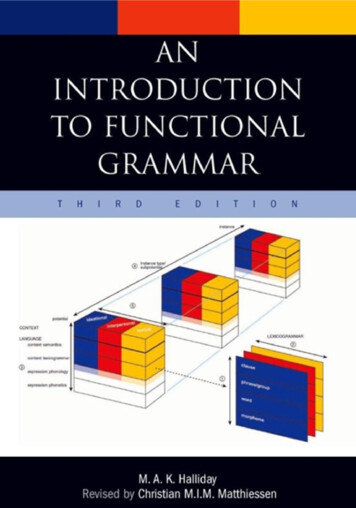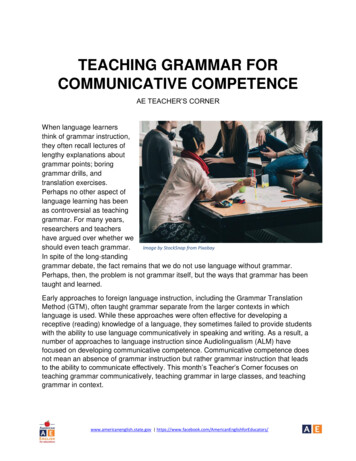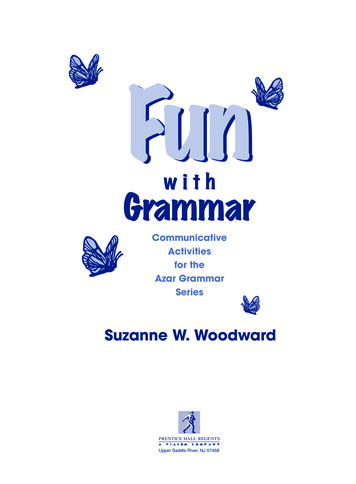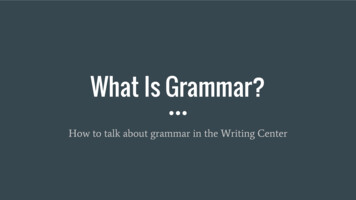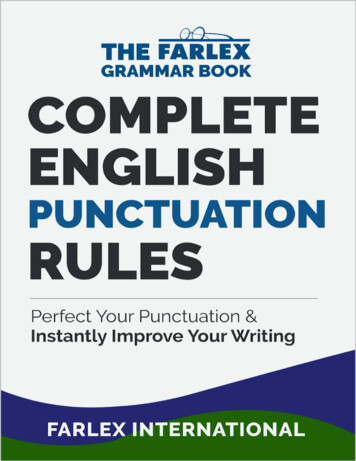
Transcription
The Farlex Grammar BookVolume IIComplete English Punctuation RulesPerfect Your Punctuation and Instantly Improve Your WritingExplore more books by Farlex at
FARLEX INTERNATIONALFARLEX INTERNATIONAL LIMITEDa Farlex Group Company USA Irelandfarlex.comfarlex.ieCopyright 2017 by Farlex InternationalAll rights reserved.Farlex supports copyright. Copyright drives creativity and creates diverse and vibrant culture. Thank youfor purchasing an authorized copy of this book and for complying with copyright laws by not reproducingor distributing any part of this work without permission.ISBN-10: 1537513907ISBN-13: 978-1537513904
About the publisherFarlex is the publishing team behind TheFreeDictionary.com, the award-winningreference destination with 1 billion annual visits.The most comprehensive reference resource online, The Free Dictionary is amassive, easily searchable collection of dictionaries and encyclopedias from themost trusted publishers, including McGraw-Hill, Houghton Mifflin,HarperCollins, and many more.Since its founding in 2003, TheFreeDictionary.com has grown to include a vastand diverse amount of reference content, including multiple thesaurus sourcesand specialty dictionaries covering fields such as science, medicine, law, finance,idioms and slang, acronyms, computing, and more, as well as dictionaries in 14other languages. Farlex dictionary apps powered by The Free Dictionary havebeen downloaded tens of millions of times across multiple platforms, with topratings after hundreds of thousands of user reviews.With the three volumes of The Farlex Grammar Book (Complete EnglishGrammar Rules, Complete English Punctuation Rules, and Complete EnglishSpelling and Pronunciation Rules), Farlex brings its reputation for the mostcomprehensive, trusted, and easy-to-use reference products in the world to themost thorough English language guides available.Complete English Punctuation Rules offers its readers unprecedented onlineintegration. Every punctuation quiz in the book can be accessed for free atTheGrammarBook.com.For more books from Farlex, visit our Amazon page.
PrefacePunctuation is essential to learning how to write. Only when we masterpunctuation can we begin to perfect our writing. More than a dozen uniquepunctuation marks are used in modern English, and each mark can change thestructure and meaning of our chosen words in both drastic and subtle ways.When we speak, we control this meaning by pausing or changing the inflectionof our voice; when we write, however, the only way to convey this meaning isthrough the correct use of punctuation marks.This guide covers all the ways punctuation shapes the English language as it iswritten today. Because of how varied the usage of punctuation marks can be, it’scrucial to understand exactly how each mark can (or cannot) be used.Each chapter in this guide focuses on a different punctuation mark, providingclear examples that show not only how to use it correctly, but how to identifyand avoid common mistakes as well. Since many punctuation marks overlapwith one another in how they are used, this book contains many cross-referencesto make it clear when and why one mark might be preferable over another.Once you have mastered the basic rules of punctuation, your writing willbecome much clearer, better structured, and more precise. You’ll be able to addmore nuance and variety to your writing without worrying about whether you’reusing the correct punctuation. With this guide, you will have no doubt.
Editor’s NoteThis book is written according to the standard styles and spellings used inAmerican English. While major differences between American and BritishEnglish are usually addressed, some information in the book might not coincidewith the styles, tendencies, or preferences of other English-speakingcommunities.
Table of ContentsAbout the publisherPrefaceEditor’s NoteEnglish PunctuationPeriodsExclamation PointsQuestion strophesParenthesesBracketsQuotation MarksEllipsesOther Signs and SymbolsQuiz answersIndexThank YouMore from Farlex
English PunctuationPunctuation refers to the specific markings, signs and symbols that are used inand around sentences to give them structure and to allow for correctunderstanding and comprehension.
Providing structureIf we think of words as bricks that build a sentence (arranged in a certain patternaccording to English grammar), punctuation could be thought of as the mortarthat holds the bricks together. Without punctuation, our writing would just be acontinuous stream of words that lacked structure, pacing, and, ultimately,meaning. For instance, let’s see how this same paragraph would look withoutany punctuation:if we think of words as bricks that build a sentence arranged in a certainpattern according to English grammar punctuation could be thought of asthe mortar that holds the bricks together without punctuation our writingwould just be a continuous stream of words that lacked structure pacingand ultimately meaning for instance lets see how this same paragraphwould look without any punctuationWhile it’s possible to discern some of the meaning, it becomes remarkablydifficult to understand what is being said when no punctuation marks are used.
Providing internal meaningIn addition to providing overall structure and clarity to sentences, punctuationcan also provide nuanced internal meaning as well; that is, sentences that havethe exact same words can have different meanings depending on whichpunctuation is used (or misused). Let’s look at some sets of examples thatillustrate this idea:“Brackets are also used to distinguish parenthetical information that appearswithin a larger set of parentheses. (Informally, though, it is quite common tosimply use a second set of parentheses.)”“Brackets are also used to distinguish parenthetical information that appearswithin a larger set of parentheses. (Informally, though; it is quite commonto simply use a second set of parentheses.)”Here, by changing the second comma after though to a semicolon, we’vechanged what informally refers to: In the first example, it is referring to the useof a second set of parentheses as being informal; in the second example, it is theuse of brackets that is now being described as informal.Now let’s look at two examples involving more complex punctuation changes:“If we look at our sales team’s report, an increase in consumer confidence,an upturn for our July figures, and successful budget cuts indicate a verypromising second half of the year.”“If we look at our sales, teams report an increase in consumer confidence—an upturn for our July figures—and successful budget cuts indicate a verypromising second half of the year.”The second sentence’s meaning is now different from that of the first in threeways:1) By placing a comma after sales and removing the apostrophe fromteam’s, the information is no longer a part of the sales team’s report.Instead, teams becomes the subject of the verb report, of which an increasein consumer confidence is the direct object.2) By placing em dashes around an upturn for our July figures, it changesthe information from being part of a list to instead describing an increase inconsumer confidence.3) Finally, because of these changes, successful budget cuts is now not a
part of a list of information but has rather become another subject: theagent of indicate a very promising second half of the year.By understanding the various nuances of how punctuation functions in asentence, we can be much more precise in the meaning we want our writing toconvey.Minor mistakes with humorous resultsSometimes, misplacement or omission of punctuation yields silly,humorous, or absurd sentences. For instance: “Attention employees: dangerous when active.” (With the correctcolon placement, this is a clear warning to employees.) “Attention: employees dangerous when active.” (Without correct colonplacement, this seems to be a warning about employees.) “Symptoms include inability to eat, feelings of paranoia, andirritability.” (With commas, the individual symptoms are easy tounderstand.) “Symptoms include inability to eat feelings of paranoia andirritability.” (Without commas, it sounds like one of the symptoms is beingunable to eat certain feelings.) “OK, let’s start moving, Jack!” (With the second comma, it’s clear thatJack is being addressed by the speaker and asked or invited to beginmoving.) “OK, let’s start moving Jack!” (Without the second comma, it seemslike the speaker is suggesting that Jack be physically moved by others.)While the intended meaning of such sentences will probably still beunderstood by the reader, it undermines the credibility of the writer to havesentences whose literal meanings are so starkly (and humorously) different,so it’s important to know where, when, and how to use the appropriatetypes of punctuation.
Types of PunctuationThere are 15 unique punctuation marks that are used in everyday writtenEnglish. We’ve categorized them together according to the similarity of theirfunction. We’ll briefly look at each one along with some examples, but you cancontinue on to their individual sections to learn more about the various waysthey are used.Terminal pointsTerminal points are those that mark the end of a complete sentence. Theseinclude periods, exclamation points, and question marks.Periods (Full Stops)Periods ( . ), also known as full stops (especially in British English), mark theend of sentences that are not questions or exclamations. For example:“I need to buy new glasses.”“She didn’t really like the play.”“Reports are indicating increased activity in the region.”“If I were able to live anywhere in the world, I would move to Beijing.”“Please don’t be angry with him for what he said.”Periods are also used to mark abbreviations, and they function as a decimal pointin non-whole numbers. For instance:“Let’s find an A.T.M. [automated teller machine] so I can withdraw somecash.”“Your appt. [appointment] has been rescheduled for next Tuesday.”“At current market value, the dollar is worth 0.89901 euros.”Exclamation PointsAn exclamation point or exclamation mark ( ! ) is commonly used to expressstrong, intense emotions in declarations or to add emphasis to interjections andcommands.
For example:“I can’t wait to travel to Paris next week!”“I can’t believe I got into law school!”“Yuck! I hate coconuts!”“That was an impressive victory! Congratulations!”“Please don’t stay out too late tonight!”“Get out of here, now!”“Go to your room this instant!”Question MarksQuestion marks ( ? ) are used, quite simply, to ask questions.While it is usually a matter of intent and preference whether to use a period or anexclamation point in declarative, conditional, or imperative sentences, we mustuse question marks in interrogative sentences (sentences that ask questions); touse any other terminal point would turn a question into a statement.Here are some examples:“How are you feeling?”“You can’t be serious, can you?”“It really ended just like that?”“How? When?”Pauses or breaksMarks that indicate a pause or break in the flow of the sentence includecommas, semicolons, and colons.CommasCommas ( , ) are primarily used to join two or more elements in a sentence—such as clauses, introductory elements, or items in a list—or to set parentheticalinformation apart from the rest of the sentence.For example:“We can go to the movies tonight, or we can just stay home.”“We have always wanted to buy a boat, sell everything, and set sail.”
“Either Tom, Bill, Jen, or Michelle will lead the seminar.”“In a way, they are both right.”“When I was traveling in Croatia, I met a lot of interesting people.”“The office, an old colonial building, badly needed repairs.”“The mirror, which was a gift from my grandmother, was broken during thestorm.”“Find me something to dig with, such as a shovel or spade, so I can plantthese flowers.”We also use commas for several technical purposes, such as listing a state orcountry after a city, writing the full date, writing long numbers, or separatingquoted sentences from non-quoted text:“I’m from Portland, Oregon, but I’ve lived in Washington, D.C., for morethan 10 years.”“I first arrived in Europe on September 6, 2010.”“There are over 15,000 protestors gathered outside Capitol Hill.”“You should,” said my doctor, “begin feeling better immediately.”SemicolonsSemicolons ( ; ) function like more powerful commas that create a strongerbreak in the sentence. They are used to join lists when the items are complex andcontain internal punctuation, as well as to join independent clauses without theneed of a coordinating conjunction (though they are used with conjunctiveadverbs). For example:“All I’m taking on the road trip is my truck, along with its spare tire; aradio, which only kind of works; and my dog.”“Jen hadn’t enjoyed the play; as a result, she didn’t recommend it to herfriend.”“I hope the traffic isn’t too bad; I don’t want to be late for the movie.”ColonsColons ( : ) are used to add information that helps illustrate or clarify. A colon ismost commonly used to introduce a list, but it can also introduce quotations andinformation that completes the meaning of the previous clause. Conventionally, acolon can only be used after text that can stand independently as a complete
sentence.Here are some examples:“There are a few things you’ll need for the trip: a flashlight, a goodcompass, a water purifying kit, clean clothes for seven days, comfortablehiking shoes, and a heavy-duty rucksack.”“If there’s anything I’ve learned from working here, it’s this: you don’t getahead in this industry by doing the bare minimum.”“My father had a phrase he was fond of repeating: ‘Hope for the best, butprepare for the worst.’”Parenthetical informationWe can insert text that has no grammatical bearing on a sentence by using thetwo parenthetical markers: parentheses and brackets.ParenthesesParentheses ( ( ) ), sometimes called round brackets, are used to separateparenthetical information that has no grammatical bearing on the structure of theoverall sentence. This can be a clause, phrase, word, or even just a punctuationmark. For example:“As I have said before (on numerous occasions), we must find a long-termsolution to this problem.”“The goal by Hendrickson (and what a goal!) secured the team’s entry intothe championship finals.”“She said I had behaved ‘like a yak’ (?) as she was leaving.”“The last time I went to Toronto, I had an awful experience. (I won’t bevisiting again any time soon!)”BracketsBrackets ( [ ] ), sometimes called square brackets, function similarly toparentheses but are only used within quoted text, indicating clarifying orexplanatory information that has been added to the quotation by the author:“She [the governor] insisted that the restructured budget would not resultin funding shortfalls for schools.”
“The acting president has confirmed that ‘[t]he U.N. will ultimately haveoversight over reunification.’”“In his analysis of the play, Thompson claims that ‘the entire second actserves to underscore the persistence of hope that is always present in oursubconscious mind’ [emphasis added].”Brackets are also used to distinguish parenthetical information that appearswithin another set of parentheses. (Informally, though, it is quite common tosimply use a second set of parentheses.) For example:“At least I’ll have some extra spending money this summer. (My cousin gotme a job at my uncle’s [his dad’s] warehouse.)”Connectors and dividersWhen we want to demonstrate a specific relationship between different letters,words, phrases, or clauses, we variously use hyphens, dashes, slashes, andapostrophes.HyphensHyphens ( - ) are most often used to join two or more words and/or affixes toform a single and unique compound word. For example:“Do you have any sugar-free cookies?”“It is the only 10-storey building in the town.”“My old-fashioned aunt would never approve.”“I don’t mean to second-guess you, but you should check the work again.”“This behavior is decidedly un-American.”There are also several technical uses for the hyphens, such as when creatingdivisions in sequences of numbers or expressing ranges.DashesThere are two types of dashes: the en dash ( – ) and the em dash ( — ).En dashes are the preferred punctuation mark (especially in publishing) toexpress ranges, scores, voting results, or connections between two people orthings (although hyphens are very commonly used instead). For instance:
“We need you to submit your expense report for January–March.”“I’ll be in the office 8:00 AM–4:00 PM this Friday.”“The board voted 5–4 to accept the proposal.”“We will begin boarding the Denver–Chicago flight shortly.”“The Republican–Democrat divide on the issue has only widened inrecent months.”Em dashes, the longest of the dash marks, are most often used in place ofcommas or parentheses to give greater emphasis to parenthetical information.They can also informally stand in for colons when introducing a list orillustrative information. For example:“Many fundamental aspects of living on one’s own—cooking, cleaning,doing laundry—are things for which many young adults are completelyunprepared.”“The committee—which I have helped set up—will investigate spendingirregularities by CEOs of charities and other not-for-profit groups.”“There are only two things I want to do on my vacation—sit on the beachand read books.”“Remember—keep your friends close, and enemies even closer.”Em dashes can also be used to represent omitted or censored words, as well as toindicate an interruption in written dialogue:“Countess M——, a prominent member of the aristocracy, was in fact aleading contributor to the resistance.”“You ———!” he shouted. “I’m going to make sure everyone knows thetruth!”“I don’t think this is a— ” he started to say when the branch suddenlybroke.SlashesSlashes ( / ) work in a similar way to hyphens, combining words and letters intocompounds. The slash is generally considered an informal punctuation mark, asit provides a shorthand way of expressing connections between words. Forexample:“Each candidate must be sure to provide his/her [his or her] referencesbefore the interview.”
“Whoever is leading the group study, he/she [he or she] needs to keepdetailed notes about how the time is spent.”“We’ll need a signed statement from you and/or your employer [one, theother, or both].”“Rent is 650/month [ 650 per month], due on the first day of eachmonth.”“This singer/songwriter’s [singer who is also a songwriter] work neverfails to impress.”Slashes are also used to form abbreviations in very informal writing, as in quicknotes or messages. For instance:“Use hyphens b/w [between] compounds.”“Our shop has been open 24/7 [24 hours a day, seven days a week] since wefirst started up 30 years ago.”“Will be late b/c [because] of traffic.”In formal writing, such as academic papers, slashes are used to show line breaksin poetry quotations. Conventionally, this is the only time when spaces are usedaround a slash. For example:“I’d like to include the following lines from Shakespeare’s ‘Sonnet 116’ inour wedding ceremony: ‘Love is not love / Which alters when it alterationfinds, / Or bends with the remover to remove: / O, no! it is an ever-fixedmark, / That looks on tempests and is never shaken.’”ApostrophesThe apostrophe ( ’ ) is used to form contractions (two words shortened andmerged into one) as well as to show possession.When used in contractions, the apostrophe replaces the letters that are omittedfrom one of the two words. For instance:“This plan doesn’t [does not] make any sense.”“It’s [it is] a very unfortunate circumstance.”“I hope you’re [you are] happy in your new job.”“Please don’t [do not] do anything you aren’t [are not] sure about.”When showing possession, the apostrophe comes before the letter “s” forsingular nouns (and irregular plurals) or after the letter “s” in regular pluralnouns:
“We were looking everywhere for Jonathan’s bike!”“The kids’ play room is a mess.”“We could stay in my family’s cabin for the weekend.”“Police are gathering witnesses’ testimonies regarding the incident.”“We’ll have to rely on people’s donations to stay open.”Quoted materialWhen we quote something that someone else has written or said, we distinguishit from our own writing through the use of quotation marks. If we omit (leaveout) any portion of a quote but keep the rest of it in its original form, we can useellipses to show where the omission exists within the quote.Quotation MarksWhenever we reproduce exactly what someone else has said, whether it’s aword, phrase, or entire sentence, we use quotation marks—either double ( “ ” )or single ( ‘ ’ )—to separate it from the rest of our writing. For instance:John said, “I’ll never live in this city again.”The CEO has expressed his ‘genuine concern and remorse’ over thedevelopments.If we use a quotation that already has a quotation within it, we alternate betweendouble and single marks:The president said, “I’ve been assured by the prime minister that she is‘taking all appropriate steps in response to the crisis.’”We can also use quotation marks to highlight text that is or might be consideredsomehow questionable, dubious, or uncertain, as in:His “promise” turned out to be a complete lie.Quotation marks also have the technical use of marking the titles of smallerpieces of written or creative works, such as poems or songs:My favorite song has always been “Auld Lang Syne.”EllipsesAn ellipsis (plural: ellipses) is a series of three dots ( . . . ) that represents
material that has been omitted from a quotation for the sake of neatness andbrevity. In general, this is only done when an omission is made in the middle of aquoted sentence; any other punctuation necessary for the structure of thesentence must be kept intact. For example:“In response to the outcome of the trial, the president said, ‘I don’t think thedecision today reflects the . . . opinion of most Americans.’”“The final passage sums up the protagonist’s view: ‘I’m sure of one thing inlife: I value family over all other things, . . . and I will never forget itagain.’”“Our local correspondent told us that ‘[a]dvocates from around the state arerallying around a new law aimed at reducing the number of roadsideaccidents. . . . Still, there are some critics . . . who feel the law will have agreater and more negative impact on commuters.’”Less formally, ellipses are commonly used to indicate when a statement trails offor is broken up due to uncertainty or hesitation, as in:“I sure hope this works. . .”“But. . . I don’t understand. . .”Other Signs and SymbolsIn addition to the 15 punctuation marks above, there are many different signsand symbols that are commonly used in everyday writing, such as the asterisk(*) or the ampersand (&). These are not standard punctuation marks—they arenever necessary to the grammatical or syntactic meaning of a sentence—but theyappear often enough that it’s important to know how they might be used.Continue on to the section Other Signs and Symbols to learn more about them.
Quiz1. Which of the following is the function of punctuation?a) To provide structure and clarity to a sentenceb) To provide nuanced meaning and intention to a sentencec) To govern word orderd) A & Be) B & Cf) All of the above2. Which of the following sentences is punctuated correctly?a) “Of all these issues, that one. is the most important”b) “There have been multiple U.F.O. sightings in these parts.”c) “Why are you so upset.”d) “There are many .abbrev used in English.”3. Which of the following are not terminal points?a) Periodsb) Semicolonsc) Exclamation pointsd) Question marks4. Generally speaking, hyphens, dashes, slashes, and apostrophes are used to:a) Demonstrate a specific relationship between different letters, words, phrases,or clausesb) Mark the end of complete sentencesc) Indicate parenthetical information within a quotationd) Indicate a pause or break in the flow of the sentence5. Which of the following uses of a slash is considered appropriate in formalwriting?a) “I just need a simple yes/no answer.”b) “Insert b/w the two marks.”
c) “Love has earth to which she clings / With hills and circling arms about— /Wall within wall to shut fear out.”d) “If an employee is late more than three days in a row, s/he will receive aformal warning.”See the answers
PeriodsDefinitionThe period (also known as a full stop, especially in British English) is apunctuation mark ( . ) primarily used to indicate the end of a sentence. It appearsas a single dot on the bottom line of the text, and it comes immediately after thelast word of the sentence without a space.There are also several minor uses for the period, which we’ll look at later in thissection.
Punctuating sentencesThe most common use of periods is to punctuate the end of sentences. Thisoccurs with almost all the types of sentences we use. For example:“I run three miles every morning.” (declarative sentence)“I could study better if you turned down the music.” (conditional sentence)“Please start the car.” (imperative sentence)Note that if we wanted to indicate an especially strong emotion in any of theabove sentences, or else indicate that the speaker is shouting, we would typicallyuse an exclamation point instead. For instance:“I run three miles every morning!”“I could study better if you turned down the music!”“Please start the car!”However, this is based solely on the intention of the writer; the form of thesentence itself doesn’t require that an exclamation point be used instead of aperiod.Interrogative sentences (Questions)The only type of sentence in which a period is not used is the interrogativesentence (a sentence that asks a question). These sentences always use questionmarks rather than periods, as in:“Would you like a bite of my sandwich?”“Where is the closest supermarket?”“Did you sleep well?”Using periods with quotation marksIf a sentence uses quotation marks to indicate something that another person hassaid, and the quotation marks appear at the end of the sentence, the period canappear in one of two places.In American English, the punctuation used at the end of direct speech alwaysappears within the quotation marks. For example:The CEO said, “This is a great day for the company.”
Our five-year-old said that when she grows up she wants to be a “doctorand a pop star and a ballerina.”However, in British English (which also uses different rules for quotationmarks), periods that end quotations are usually placed outside the final quotationmark, as in:The CEO said, ‘This is a great day for the company’.Our five-year-old said that when she grows up she wants to be a ‘doctor anda pop star and a ballerina’.One vs. two spaces after a periodWhen we begin a new sentence after another one has ended, we generally use asingle space between the period of the first sentence and the first word of thesecond sentence.However, at one point, it was standard practice to add two spaces after the endof a sentence. This trend arose out of the use of manual typewriters (in which themonotype font created a lack of space between periods and the first letter of thenext sentence). With the advent of word processor applications for computers,this problem was eliminated, but some writers today persist in adding two spacesafter a period.While this continues to be a point of contention for some, the definitive answeris that it is not only preferable but correct to use only one space after the periodof a sentence. This is a point on which all modern grammar and style guides(including this one) agree: When beginning a new sentence after a period, onlyuse a single space.
Periods with abbreviationsWhile the period is most commonly used to mark the end of a sentence, it is alsoused to mark abbreviations. In addition to standard abbreviations (words that areshortened by omitting one or more letters), there are also three sub-categoriesthat can use periods: initials, acronyms, and initialisms.However, unlike its use in punctuating the end of a sentence, the use of a periodwith abbreviations is not as strict or consistent, often depending on the location(i.e., American English vs. British English) and preference of the writer,publisher, or style guide.AbbreviationsWe often use periods to indicate when a word has been abbreviated (that is, hashad letters omitted from it) in a sentence. This period always appears at the veryend of the abbreviated word. For example:“Please cont. to page 41 for further instructions.” (abbreviation of continue)“Dr. Davis has been of immense service to the hospital.” (abbreviation ofDoctor)Note that when an abbreviation ends a sentence, the period that shortens theword also marks the end of the sentence—that is, we do not use a second period.If another punctuation mark (such as a comma or question mark) is used after anabbreviated word, it comes directly after the period. For example:“Our offices are open each week Mon.–Fri.” (abbreviations of Monday andFriday)“My new house is on Lilac Ave., just across from the old courthouse.”(abbreviation of Avenue)“Are you returning to work in Feb.?” (abbreviation of February)Titles in British EnglishFormal titles, such as Mr., Mrs., or Dr., are actually abbreviations, but we usuallyonly use them in their contracted forms in writing. Because they are so common,the period is usually left out in British English, as the abbreviation does not need
to be indicated by punctuation to be understood. It’s therefore common to read“Mr Jones,” “Mrs Smith,” or “Dr Casey” (for example) in writing that usesBritish English styles.In American English, however, these abbreviated titles are still punctuated withperiods.Initials of namesInitials are a kind of abbreviation of people’s names formed from the first letterof each part of the name (first, middle, and/or last name). We usually mark eachinit
With the three volumes of The Farlex Grammar Book (Complete English Grammar Rules, Complete English Punctuation Rules, and Complete English Spelling and Pronunciation Rules), Farlex brings its reputation for the most comprehensive, trusted, and easy-to-use reference products in the world to the most thorough English language guides available.


